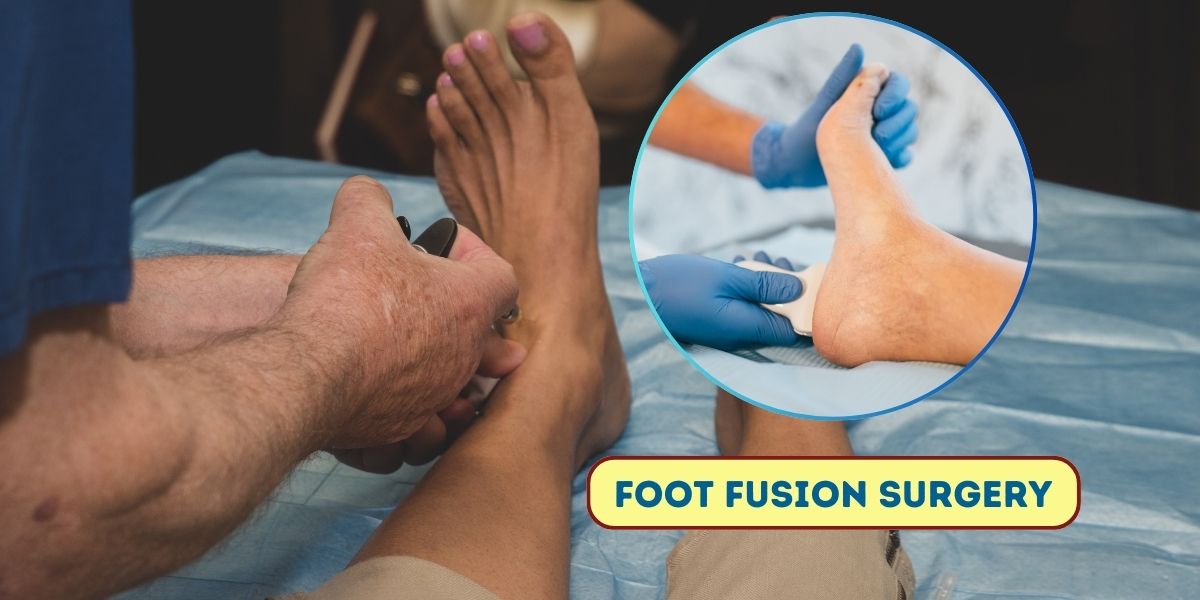Foot Fusion Surgery – A Closer Look
What Is Foot Fusion Surgery? Foot fusion surgery aims to achieve permanent fusion of separate bones in the foot. This procedure is commonly used to address the following conditions:
- Flat Feet – When the arch of the foot collapses, causing pain and instability.
- Arthritis – Foot fusion helps manage arthritis, including rheumatoid arthritis.
- Fractures – If bones in the foot haven’t healed properly or have suffered wear and tear over time.
The Surgical Process
- Preparation – You’ll spend an overnight stay in the hospital, and the surgery will be performed under general anesthesia.
- Local Anesthetic – Post-surgery, a local anesthetic is administered in the foot to minimize pain.
- Joint Removal – Damaged joints may be removed during the surgery.
- Bone Stiffening – Bones are permanently stiffened using plates fixed by screws to facilitate bone fusion as healing occurs.
- Bone Graft – In some cases, a bone graft from another part of your body or donor bone may be necessary to promote proper healing.
Types of Foot Fusion Surgery
- Midfoot Fusion – This involves joining one or two bones in the midfoot or all the midfoot joints that form the foot’s arch. The midfoot bones are naturally stiff, so fusion doesn’t significantly impact movement.
- Hindfoot Fusion – It focuses on the Chopart joint, which includes the talonavicular and calcaneocuboid joints. These joints separate the hindfoot from the midfoot and forefoot. Since this joint doesn’t usually move, permanent fusion doesn’t affect movement either.
Recovery and Long-Term Impact
- Recovery Time – Recovery varies, but expect several weeks to months. Follow your surgeon’s guidance for a successful recovery.
- Long-Term Benefits:
- Less Pain – Foot fusion aims to reduce pain significantly.
- Improved Joint Stability – Fused bones provide better stability.
- Functional Outcomes – Most patients regain functionality without adverse effects on movement.
Are there any risks associated with foot fusion surgery?
- Complications Associated with Anesthesia – As with any surgery, there is a risk related to anesthesia administration.
- Infection – Surgical sites can become infected, leading to complications.
- Damage to Nerves and Blood Vessels – During surgery, nerves or blood vessels may inadvertently be affected.
- Bleeding or Blood Clots – Post-surgery bleeding or blood clots can occur.
- Failure of Bones to Fuse (Nonunion) – Sometimes, bones may not fully fuse as intended.
- Continued Pain and Swelling – Despite the surgery, some patients may experience persistent pain and swelling.
How can I minimize the risks during recovery?
- Follow Post-Operative Instructions – Your surgeon will provide specific guidelines for wound care, weight-bearing restrictions, and physical activity. Adhere to these instructions diligently.
- Elevate Your Foot – Elevating your foot above heart level helps reduce swelling and promotes circulation. Use pillows to support your foot while resting.
- Manage Pain and Swelling
- Ice Packs – Apply ice packs to the surgical area to reduce swelling.
- Pain Medications – Take prescribed pain medications as directed by your doctor.
- Monitor Incision Site
- Keep the incision site clean and dry.
- Look out for signs of infection (redness, increased pain, warmth, or discharge). If you notice any, contact your healthcare provider promptly.
- Gradual Weight-Bearing
- Follow the recommended weight-bearing progression. Initially, you may need crutches or a walker.
- Gradually increase weight-bearing as advised by your surgeon.
- Physical Therapy
- Engage in prescribed physical therapy exercises to improve strength, flexibility, and joint mobility.
- Strengthen the muscles around the fused joint.
- Nutrition and Hydration
- Proper nutrition supports healing. Consume a balanced diet rich in vitamins and minerals.
- Stay hydrated to aid tissue repair.
- Avoid Smoking and Alcohol
- Smoking delays healing and increases infection risk.
- Limit alcohol consumption.





